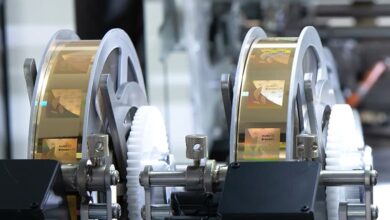Doha’s Futuristic Digitization and 3D Center

Qatar Free Zones Authority, the Polish Wolf Group, and Msheireb Properties signed an agreement to establish a digitization and 3D printing center and an art gallery in Ras Bufontas Free Zone, provided that the Wolf Group’s headquarters will be in the Doha Design District located In Msheireb Downtown Doha.
The agreement was signed by Lim Mingwei, CEO of the Free Zones Authority, Marius Kroll, CEO and founder of the Wolf Group, and Ali Al Kuwari, acting CEO of Msheireb Properties, in a special signing ceremony held in the Doha Design District in Msheireb, the world’s first sustainable downtown regeneration project, in the heart of Doha.
Under the agreement, the Wolf Group will facilitate the transformation of artists’ works from digital copies into real works of art by using different materials, including recycled materials. This helps raise awareness among artists and the public about sustainable development and its importance and adoption in artistic works, while the Center for Digitization and 3D Printing will be a destination for designers and the public alike to meet, create, and inspire new ideas and works.
On this occasion, Mr. Mingwei felt that this agreement reflected the progress of the technology sector and the development of the innovation system in the State of Qatar, as the Center for Digitization and 3D Printing (the first of its kind in the country), represents a valuable source for designers and creative companies, as well as providing unique support of its kind for companies working in the fields of manufacturing, vehicles, aerospace, and medical sciences through rapid development of prototyping and product design using innovative biocompatible materials, the center will also contribute significantly to reducing production costs and reducing the time required to deliver products and put them to market.
He added, “Sustainability is an inherent concept in all of our operations, and the recent obtaining of the GSAS certification by the free zones reflects the authority’s commitment to achieving sustainable development.”
On his part, Mr. Kroll said that 3D printing and reusing recycled materials is a cornerstone of the group’s strategy, and “we are pleased with this strategic cooperation to provide technical support and innovative solutions in various fields, including the use of recycled materials, furniture production, arts and the gaming sector.”
In turn, Mr. Al Kuwari of Msheireb Properties, said that the headquarters of the Center for Digitization and 3D Printing will be a special destination for the development of this type of large-format printing and the use of recycled materials, which will enable the production of furniture designed by the best local and international designers from around the world. In the long term, the Wolf Group plans to implement many diversified production chains.
In a related context, the Wolf Group is uniting its efforts with Msheireb Properties and the Beachfront Group to work together on the printing of the world’s largest scale model made of recycled materials. He will also lay out the interior design of the new digitization and 3D printing center.
This is part of Qatar’s preparations to host the 2022 FIFA World Cup, the largest sporting event in the world.

.gif)




103 Comments